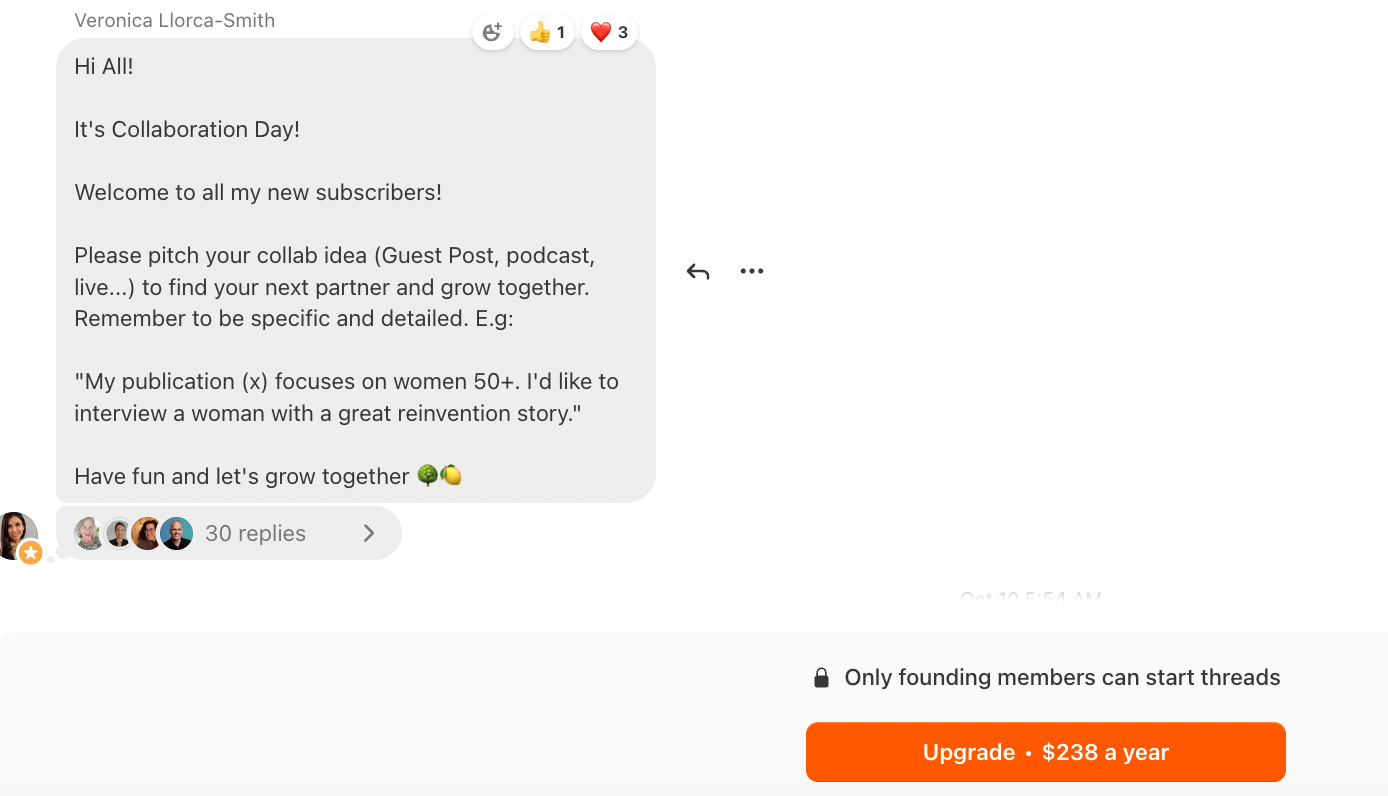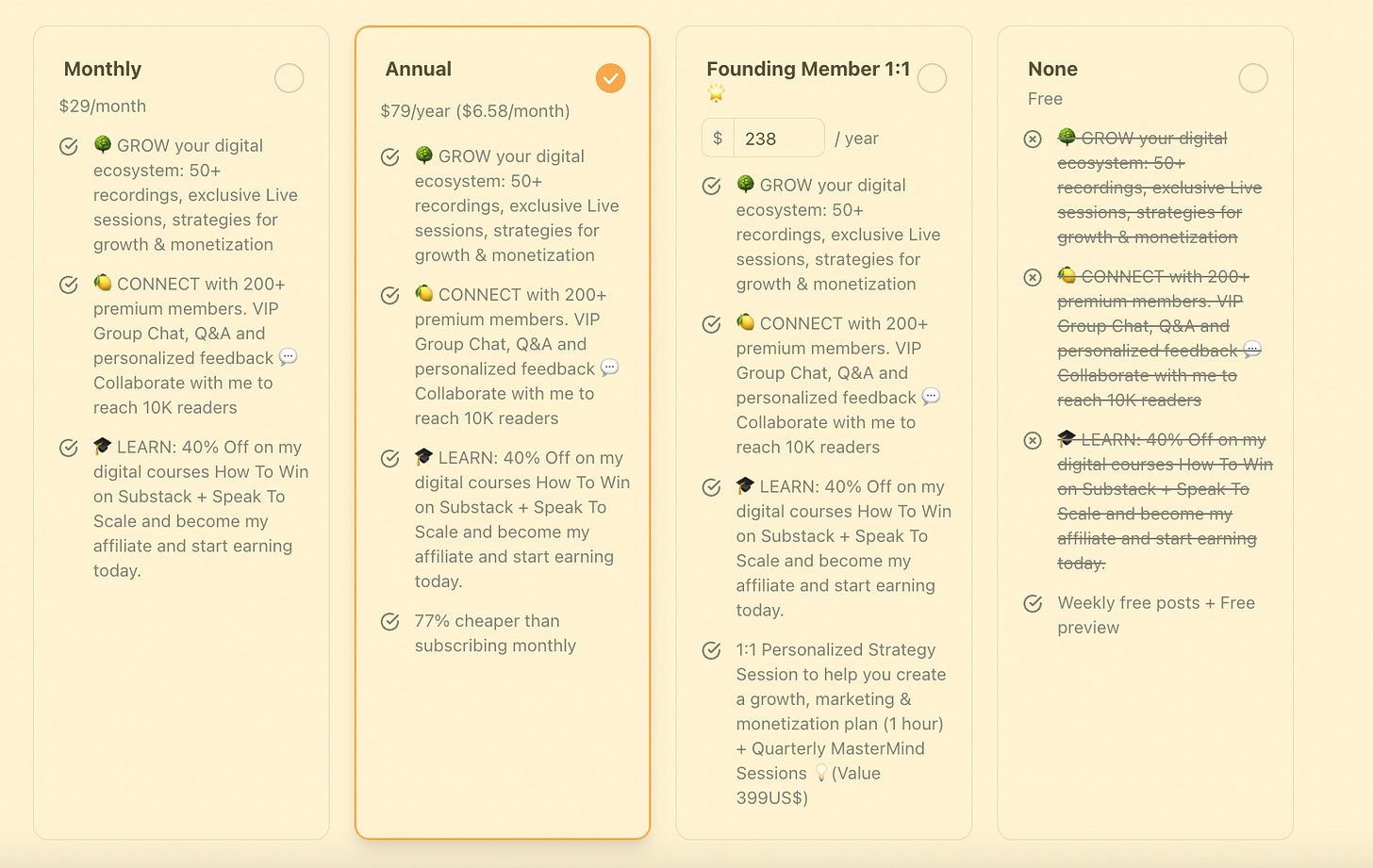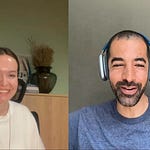Newsletter Circle is your go-to source for building a successful newsletter business through a paid subscription.
It has never been a better time to build a community
Every major wave of progress creates its counterwave.
Mass production made handmade craft special again.
Fast food sparked a renewed love for real, slow, nourishing meals.
And now, in the age of AI, authenticity and human connection are becoming more precious than ever.
Because the more content becomes automated, the more we crave original thinking.
And the more digitally disconnected life gets, the more we seek spaces that feel alive, spaces that allow us to build something together, not alone.
So, I don’t fear what AI might replace. I pay attention to what it never can: our ability to connect, collaborate, and learn from one another.
That’s where the opportunity lies for newsletter creators.
Building a community around your newsletter can be your superpower. Because the rare becomes valuable.
A community is not just an audience, it’s an ecosystem of shared learning, creativity, and collective growth.
But community building isn’t easy. It has its own rules, its own learning curve.
That’s exactly why I spoke to someone who learned it the hard way.
, the creator of , has spent the past two years turning her newsletter into a thriving online community and she nailed it.Today, her newsletter is a Substack Bestseller with over 10,000 subscribers, including 200+ paid members and 70+ founding members who join her in quarterly masterminds and private coaching sessions, engage with her and each other through Substack Chat and live sessions continuously.
But it didn’t start that way.
For an entire year, she wrote in silence. It was only when she made community building the center of her strategy and committed to it intentionally that everything shifted.
In our conversation, Veronica shared her roadmap and the lessons that shaped it. I went back through the session and distilled the most practical insights for you.
In today’s deep dive, you’ll discover:
What “community” actually means (beyond likes, comments, or follower count)
How to shift from one-way broadcasting → to multi-way connection
The 6-step roadmap to activate Substack Chat and spark real engagement
How to use personalization to build trust and long-term paid member loyalty
Why Substack is just the top of the funnel and how to monetize beyond paid subscriptions
The 4 pillars of a sustainable, community-led newsletter business
And at the center of it all is this truth:
Building a community around your newsletter isn’t about scale; it’s about depth.
It’s about creating meaningful relationships, shared learning, and lasting value that turn readers into engaged superfans.
Below are the most actionable lessons from our conversation.
(You can also watch the full live session above for the full discussion.)
Let’s dive in. Your online community strategy starts here.
From Newsletter to Community: Turn Readers into a Movement
1. Subscribers ⧣ Community
Most creators start the same way: publishing regularly, calling it a “community,” but in reality, it’s a one-way channel. The turning point comes when you move from one-to-many to many-to-many — when people start engaging not just with you but with each other.
For months, Veronica also wrote in isolation, hoping comments or replies would fill the gap.
“After my first year, I realized I was doing a lot of work, calling it community, but because it was one-way, it wasn’t really a community.
In my second year on Substack, I focused on forums where we could move from one-to-many into group discussions and collaboration.
They helped crystallize the idea of community: it’s not just about me, it’s about us.”
2. A solid strategy is non-negotiable
Understanding what community means is important, but not enough.
You need a plan and you need to act on it.
When Veronica launched her newsletter, she didn’t start with a strategy. The turning point came when she made community building the foundation of her business and began taking intentional steps to bring it to life:
Monthly webinars as an exploration phase:
She started with webinars to create a space for participation and active listening, helping her understand what her audience cared about and the challenges they faced. This became her earliest way to connect with her community and learn what they truly needed.A mastermind as a sounding board:
Webinars still felt one-directional at times: present first, Q&A last. Her audience wanted more interaction with each other, not just with her.So she created quarterly masterminds: a safe, collaborative space for shared learning and discussion, not teaching. She keeps it exclusive to her 70+ founding members.
Substack Chat as a community hub:
In the beginning, Chat felt one-sided. Over time, it evolved into a casual and active space where members asked questions, shared wins, and supported each other, like an ongoing dinner conversation, in her words.This is the platform where she keeps the interaction alive.
Substack Live for proximity and trust:
Live sessions became a key channel to reduce distance. They consistently generated stronger engagement and helped her audience feel like they already knew her.Monthly themes to drive focus and cohesion:
She chooses one main topic every month and anchors all conversations, Lives, and community touchpoints around that theme, helping her stay consistent while delivering deeper value.Early personalization to create strong first impressions:
She added a welcome video to her welcome email so new subscribers would immediately feel seen.During the early days of launching paid subscriptions, she also offered customized support (like LinkedIn audits) to strengthen early trust.
Ongoing personalization for long-term loyalty:
Today, she offers 1:1 coaching sessions to her 70+ founding members, which is a benefit that has become a major reason members upgrade to the $238 founding tier, alongside quarterly masterminds.Think beyond increasing paid subscribers, create an ecosystem
She views Substack as the top of the funnel, not the entirety of her business. In a good scenario, a paid subscription converts 2-3% for her and many creators, so her focus isn’t on maximizing paid subscribers; it’s building a community she can support in many different ways.
She has launched multiple complementary offers around her core work on Substack, including courses about building a Substack newsletter and boosting your business with public speaking and digital products on Gumroad.
Community comes first, then expansion: Build your people on Substack, and take them with you to other layers of your ecosystem.
Smart incentives that reward the community while growing revenue
40% discount on her courses for paid subscribers to make learning more accessible.
Affiliate access for paid members, offering 40% commission, turning her audience into partners instead of just customers.
A win for members and a win for community sustainability.
3. Turn Substack Chat into a conversation hub
If you’re on Substack, you already have a powerful channel to spark conversations.
When used intentionally, Substack Chat can become the heart of your community, a place where people exchange ideas, debate, collaborate, and even receive personalized support.
Yet, most creators treat Chat like a one-way announcement board. Veronica was no different in the beginning. She made many mistakes too and it was exactly those early missteps that helped her transform Chat from unanswered posts into an active community space.
You don’t need thousands of subscribers to turn Chat on.
The earlier you start, the sooner you begin listening, learning, and building a community rooted in real interaction.
This is her biggest takeaway:
“I’d have started using Chat from day one. It’s the easiest way to connect, and I wish I’d built that habit earlier.
I’d post even if no one answered, because people are still reading. They just don’t always reply.”
Here’s her 6-step roadmap to help you start using Substack Chat intentionally and make it work from day one:
1. Adopt the Right Mindset
Don’t expect instant engagement. Some chats will feel like talking to yourself — that’s normal. As Veronica put it, “Be okay with opening a chat and not having answers.”
Keep showing up consistently, just like posting Notes with no comments.
Remember: community building compounds over time.
2. Build a rhythm that feels alive
Treat Chat like a publication with its own schedule. Keep it organic but, ensure a consistent presence so members expect conversation.
Post 2–3 Chats per week to stay visible without overwhelming people.
Veronica’s cadence:
Monday: Reflection or mindset prompt.
Wednesday: Topic-based discussion (AI, visibility, confidence).
Friday: Open Day — a collaboration chat where readers share projects, find partners, or ask for help.
3. Choose topics people already care about
Bring up themes your community already has opinions about. That’s where conversations come alive.
Veronica asks smart questions that she knows her community is interested in:
“Do you enjoy video content, or do you prefer text-only?”
“How can writers use AI without losing authenticity?”
Healthy debate keeps Chat dynamic and creates deeper bonds among members.
4. Ask Specific, Easy-to-Answer Questions
Avoid broad prompts like “What do you want me to talk about next?”
That’s homework for your audience and nobody wants homework.
Do your prep first. Narrow it down to clear options so people can react quickly.
Example: “Would you prefer next month’s session on public speaking to focus on hosting live sessions or podcasting?”Keep it short, simple and clear: 2–3 choice questions get far more replies than open-ended ones.
Instead of asking “What is your favorite webinar format, she asked:
“Do you prefer webinars with slides or without slides?”
That post “exploded with comments.”
“Everyone had an opinion. That’s when I realised the simpler the question, the better the engagement.”
5. Encourage collaboration, not empty engagement
Skip engagement-bait tactics that lead to a dopamine rush.
Veronica deliberately avoids “boost” or “drop your Substack link” threads.
Instead, her Open Day threads invite context and generosity: people share what they’re building and how they can support others.
Over time, those threads have sparked collaborations between readers who later co-hosted podcasts, newsletters, and courses together.
“Real community isn’t about empty engagement. It’s about adding value.”
Share a ready-to-use template they can copy and fill in.
For example, if you run a newsletter for newsletter creators, a strong collaboration pitch could look like this:
“My publication [name] focuses on [topic]. I’m looking for [guest posts/interviews / podcast swaps]. Here’s my link: [URL].”
6. Keep it personal for paid members
Use paid-only Chats to deliver custom advice. This adds clear monetizable value, a tangible benefit of being a paid subscriber.
If you plan to give coaching/consulting services on a regular basis, test your idea on Chat to understand the biggest needs/problems of your audience.
“For my paid members, I open private chats where they can share their elevator pitch or newsletter idea, and I give them feedback.
It becomes a coaching space.”
4. Use personalization from day one
For free subscribers, your welcome e-mail is your chance to make a great first impression and build trust as a community leader. Make it unique and personalized.
Veronica put a video in her welcome e-mail and received a lot of positive feedback on how nice it is to have an actual welcome from a real person and not Claude, some AI bot.
“Your free subscribers, it’s really important that you give them a great experience. Even if they’re free, put the bar really, really high so that people really trust you and they buy into you.
And I think this mindset is so, so critical.”
For paid members, when you’re starting, it is manageable to offer customized services. Use these early days to build strong bonds that will increase retention.
“So when I started, I used to do things like, for example, a free LinkedIn audit process for my paid subscribers.
So, a message for the audience today, when you’re small and you’re starting, this is a good opportunity for you to offer something customized.
Maybe it’s a 30-minute coffee chat, could be an audited service, whatever that might be.”
5. Encourage longer-term commitment for paid members
1. Make an annual subscription is a no-brainer
Veronica’s paid membership strategy is an extension of her community ethos. Her pricing strategy makes it more logical to become an annual or founding member.
Monthly: $29
Annual: $79 (about 77% cheaper than monthly)
Founding Membership: $238
“For someone who loves your work, this long-term commitment also helps build a community. Because people invest in something for a longer time, so they will not leave after a month, this is for sure.
So you have the chance to nurture all these relationships throughout this time period.”
2. Don’t be afraid to increase your membership prices
Encouraging annual & founding membership doesn’t mean that you should keep your prices too low. Increase your prices as you offer more value.
Veronica‘s founding tier started at $99, grew to $159, and now sits at $238, a change driven by new benefits and deeper engagement.
“When I realised I was helping members get paid subscribers or write books, I increased the price because I was adding real value.”
Her founding members receive additional perks such as:
A one-hour private and personalized 1:1 strategy session.
Access to quarterly mastermind sessions.
3. Offer personalized services to founding members
Veronica has over 200 paid members, and 70+ of them are founding members, a strong signal of trust and long-term commitment. It’s a result of the solid exclusive benefits she offered to founding members, which include quarterly masterminds and 1:1 personalized strategy sessions.
She noticed that most webinars, including hers, were still one-way: present first, Q&A last. But when she asked her community what they really wanted, the answer was clear: a sounding board, which is a space to exchange ideas, collaborate, and learn with each other.
That insight changed everything. She shifted from teaching to facilitating and created a safe, interactive space where conversations could flow freely. That’s how she created quarterly masterminds.
“That’s something that really has helped me consolidate and crystallize this idea of community and evolve from a newsletter to a real community where it’s not just about me, it’s about us.”
Another reason why founding membership is one of her most popular offers because many members want dedicated, one-to-one strategy sessions and focused, personalized guidance.
So, understanding what your audience needs is crucial to crafting relevant, personalized paid benefits.
6. Think beyond paid subscription: Substack is the top of the funnel
Veronica notices a pattern among creators, especially her own clients and the 70+ founding members she’s spoken to. Many get stuck on a single question:
“How do I get more paid subscribers?”
Her answer flips the script:
“Paid subscriptions are only one way to monetize your work.”
For her, Substack isn’t the end destination; it’s the top of the funnel.
It’s where she builds trust, audience, and community. Once that foundation exists, the opportunities expand naturally.
She approaches her business as a digital ecosystem, not a one-stream subscription model. This enables her to:
Host external webinars and workshops
Offer coaching sessions beyond Substack
Sell digital products (she already has 7–8 on Gumroad and plans to create more)
Publish books and other paid resources
She’s also candid about conversion rates. Most creators, herself included, convert around 3% or less.
Which is exactly why she urges creators to think bigger. If you rely only on paid subscription growth, you limit your potential. But when you treat Substack as the starting point, you unlock multiple ways to serve and monetize your community.
Her approach is clear:
Build the community first. Then create more places they can go with you.
7. Find your people, collaborate and grow together
When I asked Veronica what she would do differently if she could rebuild her community from scratch, her answer was immediate and honest:
“I wish I had focused less on doing all the work alone and more on finding collaborators.”
In the early days, her energy went entirely into creating content, writing, planning, and publishing. It took her over a year and a half before she wrote her first guest post, which now feels almost unbelievable to her.
“We’re solopreneurs, yes. But that doesn’t mean we have to be solo.”
Looking back, her biggest unlock would have been reaching out earlier, partnering with others, and building in public together rather than quietly alone.
Her advice to anyone starting out or struggling to grow:
Find collaborators early
Look for people whose work aligns with yours, co-host, co-write, co-create
Build momentum together, not in isolation
She sees community building and collaboration as the same game. Borrowing from her sports background, she adds:
“In triathlon we say: together we run further. The same is true in the world of creativity.”
8. Give Before You Ask
Here is Veronica’s biggest advice to newsletter creators who plan to build a community.
“Give before you ask. Most people in your community also want to be seen and heard. Try to engage first with the people who are already supporting you the most.”
Final words: 4 pillars of building a thriving newsletter business
Veronica’s framework for growing and monetizing her newsletter rests on four levers: service, proximity, community and personalization.
The future is to think about these levers and each lever plays a unique role:
Service: Give tangible value beyond content. Her live sessions, Q&As, and coaching programs exist to help people, not just inspire them.
Proximity: Show up as a human being. She regularly appears on camera, speaks live, and uses voice and video to reduce distance.
Community: Create a sense of shared purpose. Veronica designs spaces where readers learn together, not just from her.
Personalization: Keep interactions intimate. A simple name mention, quick note, or private DM creates loyalty that no automation can replace.
What I liked most about Veronica’s approach is how intentionally she connects her four growth and monetization levers so they strengthen one another.
Her Substack Live sessions, for instance, aren’t just random events; they bring proximity to her subscribers, allowing her audience to see and hear her as a real person.
That proximity builds trust, which naturally leads people to want to be part of her community.
And within that community, she continues to serve through masterminds, Chat discussions, and collaborations, creating more opportunities for personalized interactions that deepen loyalty.
Each lever feeds the other, forming a system where service, proximity, community, and personalization continuously reinforce one another.
Final Takeaway
The truth I kept coming back to while talking to Veronica:
Community building isn’t the easy path, it’s the meaningful one.
Not because it scales faster, but because it lasts longer.
Not because it’s frictionless, but because it’s real.
We’re moving into an era where attention is cheap and connection is rare.
The creators who win won’t be the loudest ones, they’ll be the ones who make people feel seen, supported, and part of something bigger than themselves.
So if you’re still early, if you’re experimenting, if your Chat feels quiet, or if you’re wondering whether this is all worth it, take this as your sign:
It is. More than ever.
Start imperfectly. Show up consistently.
Reach out first. Ask thoughtful questions. Build alongside others, not alone.
There has never been a better time to build your community.
Thank you for reading and see you next week.
Ciler
Find me on Substack Notes & LinkedIn














